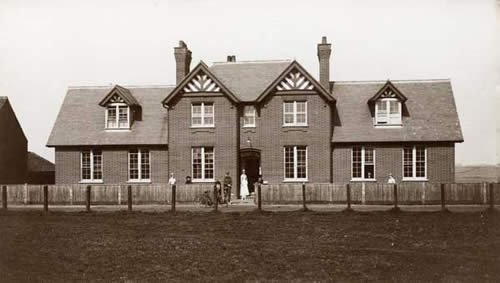How did Southwold develop?
Southwold remained a small village for many centuries and was subsidiary to Reydon which had its church of St. Margaret’s and for which Southwold's chapel was an outpost.
But between 1430 and 1460 the great church dedicated to St Edmund was built as one of a group of similar large churches in the immediate locality. It is assumed that this work was done under the aegis of Richard Russell then MP for Dunwich. This must be an indication of considerable prosperity in the area at that time.
Buckenham House was built in the mid 16th century with a long underground cellar (now the coffee shop) where merchandise was stored. It was one of a number of large properties built by local merchants.
The growth of that prosperity continued slowly until, in 1659, it suffered a major setback with the Great Fire. The loss of property and premises was compounded by the drift away from town of those who had been made homeless.
It took some time for enough wealth to be created to sustain development. A large house was built on the site of what is now Somerfield. In the mid 18th century a house (now Lloyds Bank) was built. This was followed at the end of the century by the Manor House on the High Street. All of these houses were the homes of wealthy local merchants.

The Manor House
By 1829 the layout of the town, as we would recognise it today, was well established and recorded on a map included in Robert Wake’s History of Southwold. This shows very clearly the growth of a middle-class residential area based on Gun Hill. Before that the town’s principal inhabitants had been fishermen, sailors and manual workers.
In 1750 the Government made Southwold the centre for the ‘Free British Fisheries’ in order to overcome the Dutch dominance of the herring fisheries. (For more on the Free British Fisheries, click on the FISHING storyline.) As part of the wave of development which this brought about, warehouses and wharves sprang up on Blackshore, a net house was built on the Common and a tan office and cooper’s workshop in the town. This new vitality lasted only 21 years by which time the continuing problems with the harbour brought about its failure. There was renewed hardship.
In 1841 the site of the old Guildhall was purchased for £315 and a National School (amongst the earliest) was erected. This has now been replaced by the existing school building.
In 1889 the East Coast Development Co. approached the Corporation with a proposal to develop Southwold as a holiday resort. (Click on the HOLIDAYS storyline for more about the East Coast Development Co.) By any standards this would constitute a major increase in the size of the town. In addition to a new pier, the package included land development, hotels and an electricity system. The Corporation agreed to sell their Town Farm Estate to the Company for £8,000. This covered an area stretching from the cliffs to the Railway Station and from St Edmunds Green almost to Buss Creek. The Company took on responsibility for the development of Pier Avenue, Cautley Road, Marlborough Road (one side), Field Stile Road (part) and Hotson Road and laid out roads, sewers and services. They then offered serviced plots for sale. However, development was slow and by 1927 very few houses had been built.
The Company also built the Grand Hotel and the Station Hotel (now the Blyth) as well as developments in Reydon including the Randolph Hotel. They installed the electricity generating station and part of the distribution system, bringing electric street lighting to the town.
The Company also built the Pier to accommodate their Belle Steamers, thus bringing more visitors to Southwold.
In 1903 a new cottage hospital was opened on Field Stile Road on the site of an earlier isolation hospital. This was an initiative of the town Corporation to celebrate the Diamond Jubilee of Queen Victoria.

The hospital in 1910, seven years after its opening. P1480
The income generated from the sale of the Town Farm Estate enabled the Corporation to build Council houses for workmen in St Edmunds Road; 16 in 1905 and a further 12 in 1913. This placed Southwold amongst the first councils to provide low-cost rented accommodation.

Official opening of some of the country's first council houses in St Edmund's Road, Southwold in July 1905. P1146
Not all was sweetness and light , however!! The Gooding collection (a former Town Clerk’s Commonplace book) contains the following in an unsigned letter-:
“…LOST between the months of September 1888 and August 1900 a quaint little fishing village answering to the name of Southwold, age unknown, colour blue and brown with green spots. Clothed simply and prettily. When last seen was being chased by the East Coast Development Co. Anyone giving advice or information which will lead to its recovery will receive the hearty thanks of its friends and well wishers…..”
Plus ça change!
Why not buy a copy of Discovering Southwold , available in the Museum Shop and explore for yourself the wealth of buildings in the town.